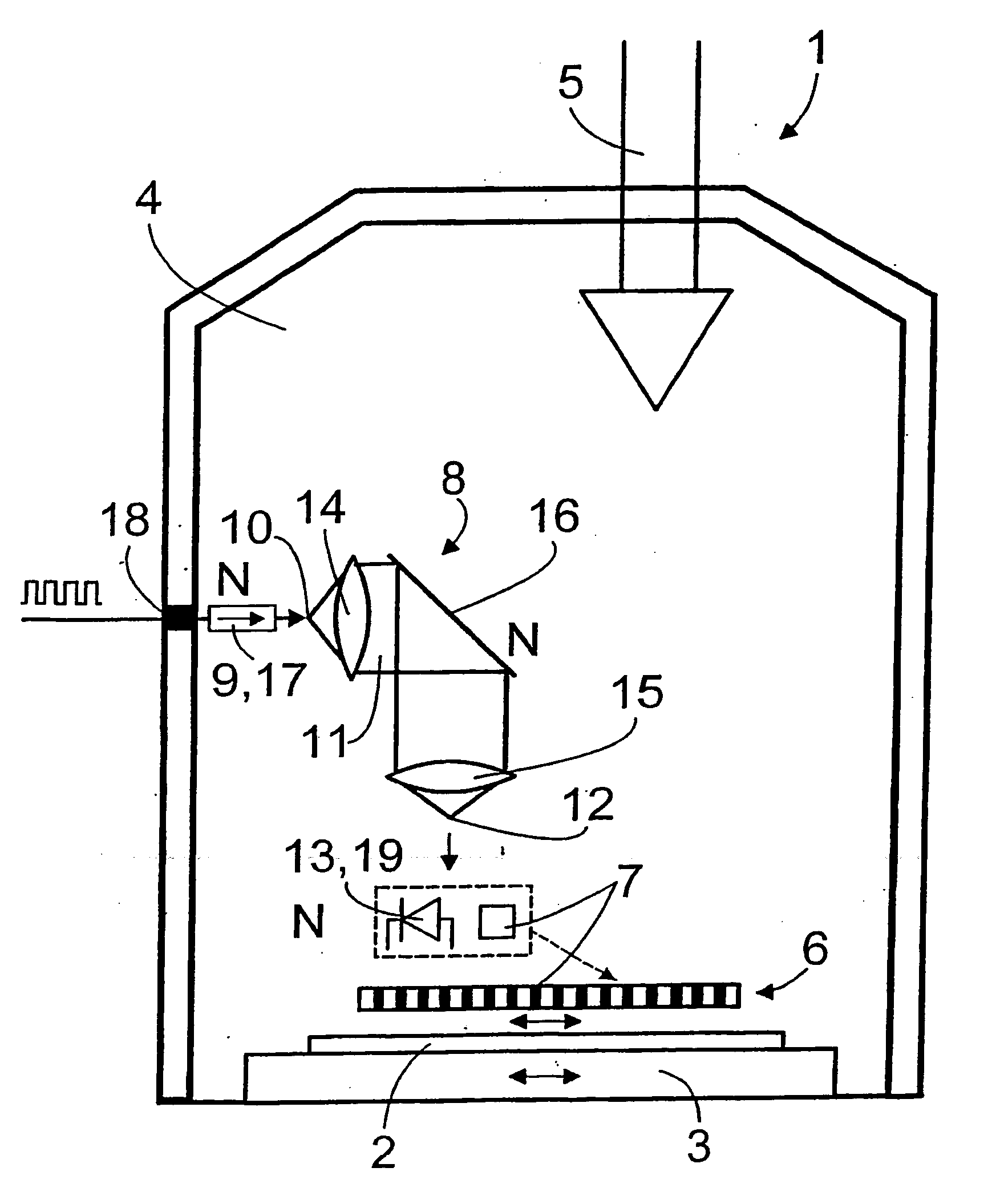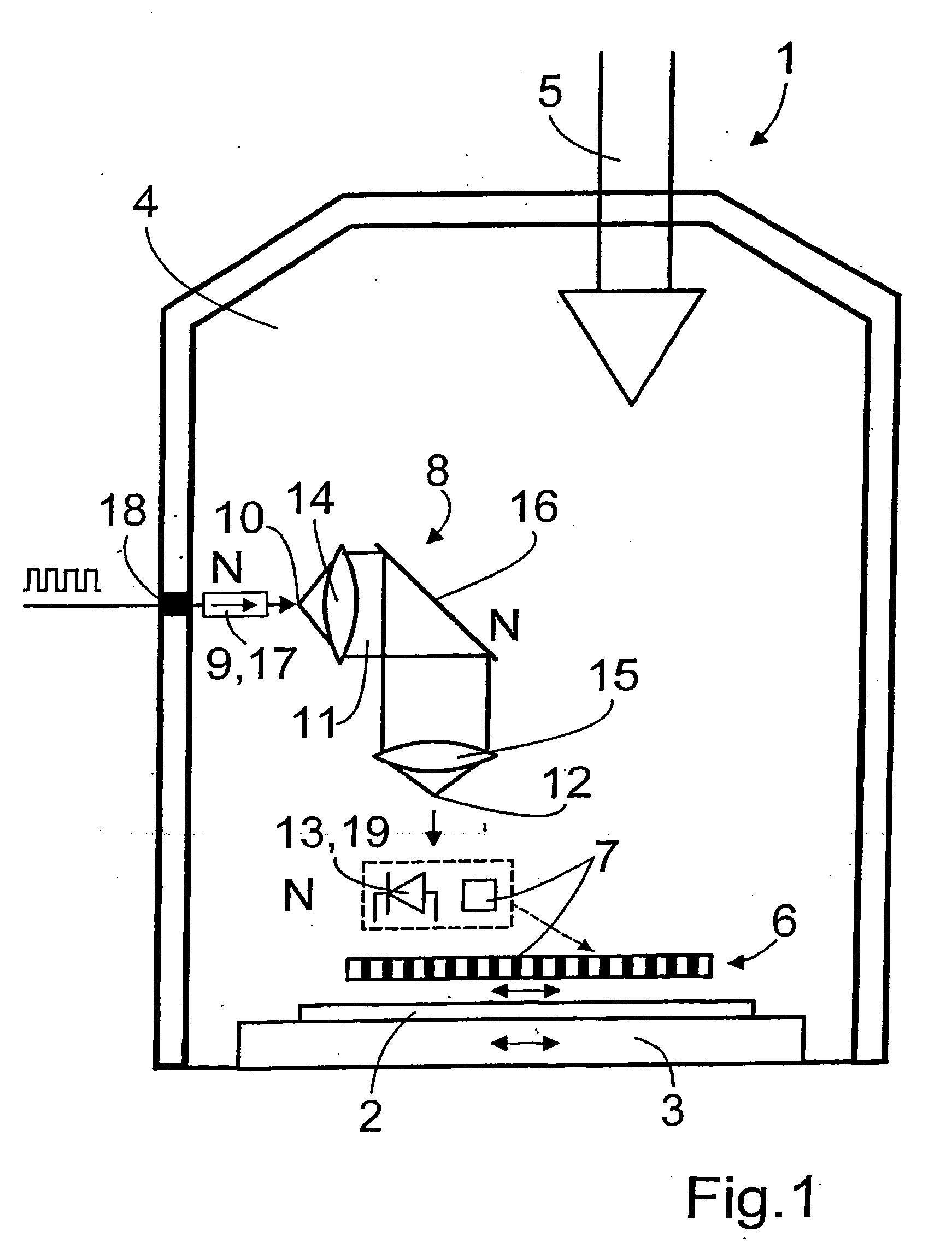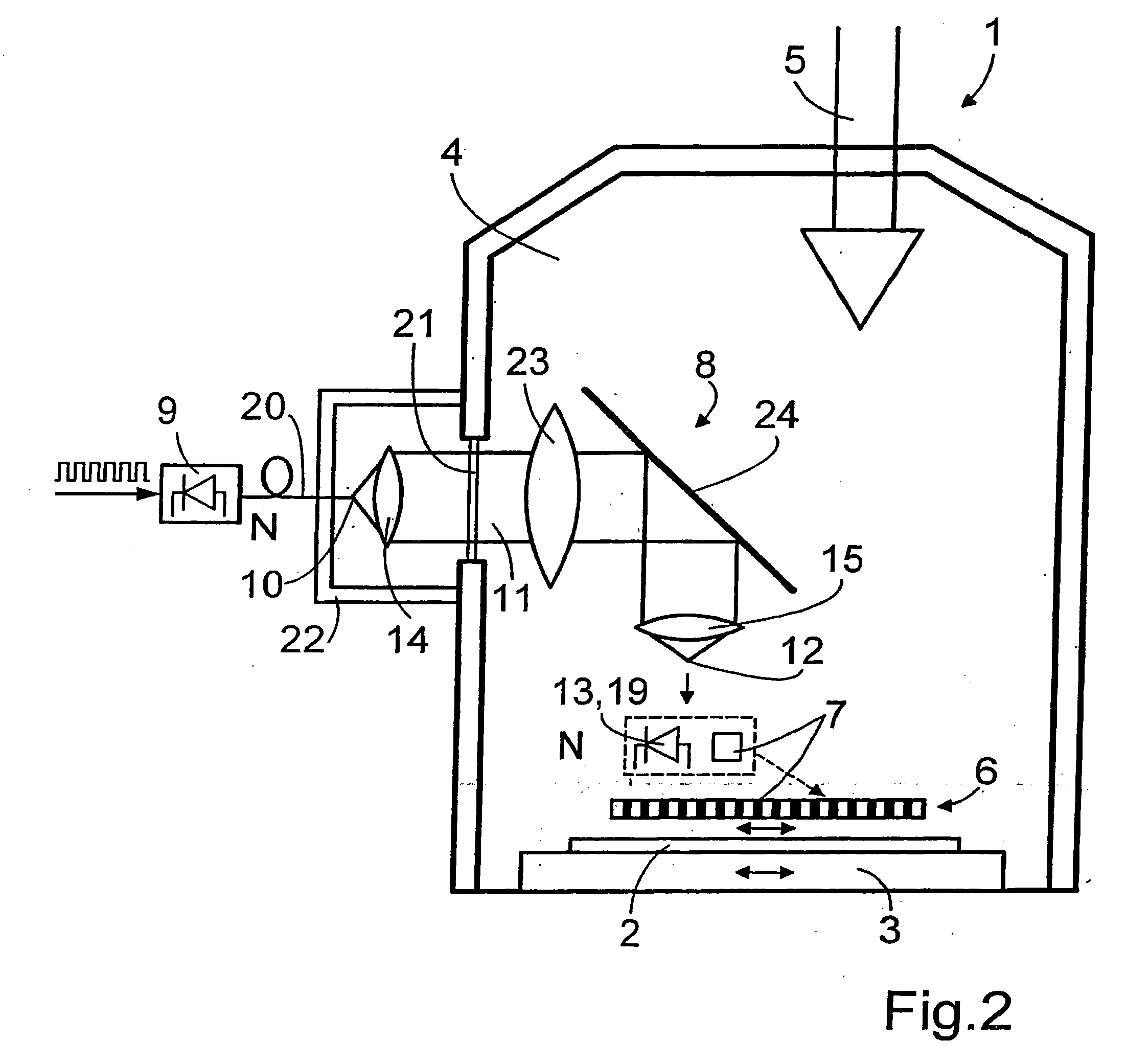[0007] It is an object of the present invention to provide a
lithography system having an addressable
pattern generation system and having a data
transmission system which enables even highest data rates to be transmitted reliably to the inside of the vacuum chamber, and in particular in which no mechanical strain on the pattern generating system due to contacts or any space related problems occur. It is an additional object to provide simple allocation of the transferred data to the addressable individual elements in the pattern generating system. It is a further object for the data
transmission system according to the present invention to be robust in terms of operation and to allow easy
assembly and disassembly.
[0009] Such an arrangement facilitates both the transformation of the
high data rate to be transmitted into the efficient optical range as well as the data transfer in a free beam connection system, which date transfer is not dependent on wiring (
data lines). The opto-electrical data
transmission system in the lithography system permits keeping the pattern generating system free from cumbersome wire-bound and mechanically straining connections to the outside, and thus enables relief from mechanical strain. Therefore, upon assembling or maintaining the lithography system, cumbersome wired connections for data transmission do not need to be made or removed directly at the pattern generating system. In the present invention, the entire data transmission is based purely on
optics and is independent of wiring, at least directly in front of the pattern generating system, owing to the integration of a free beam connection system. The opto-electrical data transmission system is very efficient, so that even the highest data rates can be transmitted. The electro-optically converted data are guided as parallel free beams directly to the pattern generating system, with the number of the parallel free beams being adapted to the
data rate to be transmitted via the predetermined
transmission rate of the electro-optical
converters. Assuming an exemplary data rate of 10 Gbits / s per electro-optical converter, 256 parallel free beams are required for transmitting a data rate of 2.56 Tbit / s. These parallel free beams' paths are directed at the opto-electrical
converters in the pattern generating system. From there, the data, which are converted into electrical signals, are guided to the individual elements of the pattern generating system via subsequent
signal processing. In an exemplary embodiment, the opto-electrical
converters in the pattern generating system accordingly detect the incoming optical data at their data rate of 10 Gbits / s. In the region of the free beams, which are independent of wiring, the light serving as the data carrier in the vacuum chamber is neither influenced by the
high voltage present therein during structuring, nor by the
particle beam, whose particles are usually ions or electrons. This has a great
advantage in that the data can be optically irradiated directly onto the opto-electrical converter—accepting that their paths cross the particles' paths—without occurrence of any problems with respect to potentials. Space consuming and complex bundles of wiring and their mechanical contacting are not required.
[0012] According to a further embodiment of the present invention, the light exit locations may be disposed outside the vacuum chamber, and the free beams may be guided into the vacuum chamber through a light transparent window in the vacuum chamber. In this way, the data transmission to the inside of the vacuum chamber is already independent of wiring and achieved by free beams. The free beams are guided simply through a window, which is integrated into the wall of the vacuum chamber. When the light exit locations are positioned outside the vacuum chamber,
space requirements and efforts associated with mounting the free beam connection system inside the vacuum chamber are reduced. No passage for any wiring for data transmission into the inside of the vacuum chamber is required, and a complete decoupling from the high vacuum and from the high
voltage fields inside the vacuum chamber results. Deflection of the free beams, which enter the inside through the window, onto the opto-electrical converters is again readily achieved by optical deflection arrangements. Any suitable deflector may be used. In order to save space outside the vacuum chamber also, a further embodiment of the present invention provides that the light exit locations are disposed directly at the window from the outside. Thereby, a series of further constructional simplifications may result, which are discussed further below. In addition, the light exit locations may advantageously be disposed orthogonally below the window, and the free beams may be guided via an additional optical deflection arrangement through the window into the inside of the vacuum chamber. Thus, deflection arrangements may also be provided outside the vacuum chamber in order to be able to guide the free beams in an optimal space saving manner. Finally, according to a further embodiment of the present invention, the window may also be recessed into the vacuum chamber. This enables a space saving positioning of the light exit locations on the outside, but still within the region of the vacuum chamber. Furthermore, predetermined optical distances may be met more easily. This is described in more detail later on in the general description and the exemplary embodiments. In order to avoid interfering influences due to
stray light and other effects, when free beams are irradiated from external light exit locations through the window, it is particularly advantageous if the window is provided with a cover shielding against external light and electromagnetic fields in a region outside of the passing free beams. The covers may be simple mechanical or optical covers. Furthermore, the free beams may be grouped into arrays, which are locally precisely defined and whose surrounding is therefore easier to cover.
[0017] The present invention can facilitate electro-
optical data transmission into and from a closed, badly accessible space having extreme conditions on its inside using a free beam connection system. Additionally, it is, however, possible—at least for relatively small amounts of energy—to realize an optical transmission of energy into the inside of the vacuum chamber without use of wires, in order to induce a process in the vacuum chamber, for instance, such as a switching process, to generate an electrostatic field or to charge up an
energy storage. According to a further embodiment of the present invention, an
optical energy transmission onto the addressable pattern generating system may be advantageously carried out using the opto-electrical free beam connection system.
 Login to View More
Login to View More  Login to View More
Login to View More 


